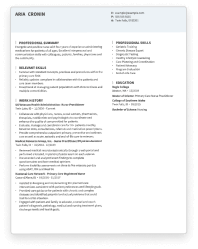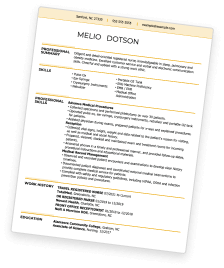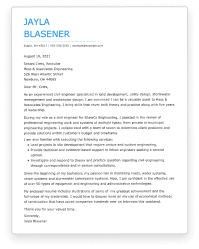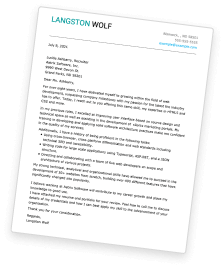Costume Designer Resumes: Overview
As a costume designer, your role is all about bringing the visual essence of characters to life in the entertainment industry by conceptualizing, designing, and creating costumes that enhance the overall storytelling experience.
Costume Designers can be found in various environments, including:
- Film and Television Productions
- Theater and Live Performances
- Fashion Shows and Runways
- Themed Events and Amusement Parks
Skills in costume design include a keen eye for detail, creativity, strong knowledge of fabrics and materials, and the ability to work closely with others.
With our help, you can build the best resume for your next job as a costume designer. Check out our entire collection of customizable resume examples and downloadable templates for more resources.
Costume Designer Resume Example
This exceptional resume template for a costume designer is the perfect example of how to mix creative design elements with quality information.
-
Quantifiable Achievements:
This resume provides specific information related to the candidate's experience in costume design, which provides unique context and demonstrates their value to employers.
-
Visually Engaging:
The bold blue header and the use of rectangular headings helps this costume designer resume pop off the page to help create a memorable impact on the reader.
-
Professionally Organized:
The visual design elements of this resume do not prevent it from appearing clean and easy to read, which helps establish a sense of professionalism.
-
Keyword Optimized:
Using phrases such as "analyze submitted costume designs and report achievable expectations" help specialize this resume to the specific needs of a costume designer job opening, which is especially helpful with applicant tracking systems (ATS).
Costume Designer Resume Template
Here we have another excellent costume design resume example that provides a framework on how to showcase qualifications effectively.
-
Creative Design:
With geometric elements in the headings, as well as a modern layout of information, this resume's creative design helps imply the artistic capabilities of the costume designer.
-
Effective Summary:
Straightforward and engaging, this resume's professional summary clearly outlines the work history and skills of the candidate and why they would make a great costume designer.
-
Relevant Experience:
Positions as a costume designer, assistant costume designer, and intern all help to build the case for this candidate's qualifications, especially since the experience comes with quantifiable achievements to underscore their value.
-
Effective Use of Whitespace:
This resume blends information together with the whitespace of the page to help prevent it from being too overcrowded and hard to read.
How to Write a Costume Designer Resume: A Step-by-Step Guide
Crafting a compelling resume is the first step toward landing your dream costume designer job, so use our step-by-step guide to create a resume that gets noticed.
-
Choose a Format:
There are three types of resume formats, and you should pick the one that best fits your needs. The chronological resume format is the most common and focuses on job history.
The functional resume format is less common and not as ATS-friendly, however, it is good for those with less experience, like recent high school graduates, because it focuses on transferable skills. Finally, there is the combination resume format, which uses elements from both the chronological and functional approaches.
-
Contact Information:
Include your full name, professional email address, phone number, and location (city and state). You can also link to a LinkedIn profile or online portfolio if it provides relevant costume designer credentials.
-
Summar or Objective:
Kickstart your resume with a powerful summary or objective statement. A resume summary, typically 2-3 sentences, highlights your relevant experience, skills, and what you bring to the costume designer role.
An objective statement outlines your career goals and how they align with the position. Choose the one that best suits your situation and customize it for each specific job application.
-
Work History:
Mention your costume designer experience and any relevant transferable skills if you're just starting your career. Include your job titles, the names of companies or productions you've worked on, dates of employment, and a brief description of your key responsibilities and accomplishments, quantifying them when possible.
-
Skills:
Provide a dedicated section to relevant skills, especially hard skills and technical skills, that help your resume stand out and show that you have the abilities to be an excellent costume designer.
-
Education:
List your educational background, including degrees, the institution's name, graduation dates, and any relevant coursework or honors. Include any specialized costume design training or certifications.
-
Additional Sections (optional):
Depending on your experience, you may consider adding sections such as professional memberships, awards, honors, languages, and volunteer activities. Ensure this information is relevant and demonstrates your commitment to quality costume design work.
Key Skills and Certifications For Costume Designer Resumes
Including the right combination of hard skills, soft skills, and certifications can help set your resume apart from other costume designers. Check out the most popular below!
Top 5 Hard Skills for Costume Designer Resumes
- Costume Design and Construction: Proficiency in designing and creating costumes tailored to characters and settings.
- Fabric Knowledge: A technical skill in understanding various fabrics, their properties, and how to use them to achieve specific design goals.
- Creativity and Digital Artistic Flair: The ability to think outside the box, envision unique costumes, and bring them to life, especially with computer programs to aid your visions.
- Time Management and Organization: Essential for meeting production schedules and deadlines.
- Historical and Cultural Fashion Trends: Knowledge of fashion history and cultural influences to accurately portray different periods and settings.
Top 5 Soft Skills for Costume Designer Resumes
- Collaboration and Teamwork: Effective communication and working harmoniously with directors, actors, and production teams.
- Attention to Detail: A critical skill for ensuring that costumes precisely match the vision and characterization.
- Adaptability: The capacity to adjust to changes and unexpected challenges during production.
- Creativity: Harnessing your imagination to create innovative and captivating costumes.
- Problem-Solving: Quickly finding solutions to costume-related issues that may arise on set or during a performance.
Top 5 Certifications for Costume Designer Resumes
- Costume Society of America (CSA) Certification: A respected certification for costume design professionals.
- Fashion Institute of Technology (FIT) Courses: Enroll in FIT’s courses focused on costume design for additional training.
- Certified Wardrobe Technician (CWT): Offered by the Entertainment Services and Technology Association (ESTA), this certification demonstrates expertise in costume management.
- Theatrical Wardrobe Personnel Training: Gain valuable theater costume management and repair expertise.
- Art and Design Workshops: Attend workshops focusing on creative aspects of costume design to enhance your skills.
These certifications and skills for your resume can highlight your best qualities. However, remember to constantly tailor your resume to the specific costume designer position you are applying to and provide relevant skills and certifications.
Helping Job Seekers Like You
7 Tips For Writing A Costume Designer Resume
- Tailor Each Resume: Customize your resume for each job application, emphasizing relevant skills and experience that match the specific role you’re applying for.
- Showcase Your Creativity: Your resume should be a reflection of your artistic flair. Use design elements and layouts that highlight your creativity.
- Highlight Relevant Experience: Emphasize costume design projects, productions, or roles that directly relate to the job you’re seeking.
- Quantify Achievements: Whenever possible, quantify your accomplishments. For instance, “Designed costumes for a cast of 50 actors” or “Reduced costume production costs by 15%.”
- Include a Portfolio Link: If applicable, provide a link to your online portfolio to showcase your work visually. It’s especially beneficial in this creative field.
- Keyword Optimization: Incorporate relevant keywords from the job description in your resume. This can help your resume get noticed by Applicant Tracking Systems (ATS).
- Stay Updated: As the costume design industry evolves, make sure your resume stays current. Highlight any additional skills or new experiences gained.


Save Time With Hloom's Resume Builder
Key Takeaways
Tailoring your Costume Designer resume to match the job you're applying for is essential. Highlight relevant skills, experiences, and artistic abilities to stand out.
Your resume should be visually appealing and provide a clear and detailed overview of your costume design skills, projects, and achievements.
Focus on showcasing your hard and soft skills while considering certifications that can boost your credibility in the field.
Follow a structured approach to resume writing, starting with the right format, clear contact information, an engaging summary, and detailed work history.
Costume design is an ever-evolving field. Keep your resume updated to reflect new experiences and skills while staying connected with industry peers to enhance your career.
More Resume Examples
Save Time With Hloom's Cover Letter Builder








